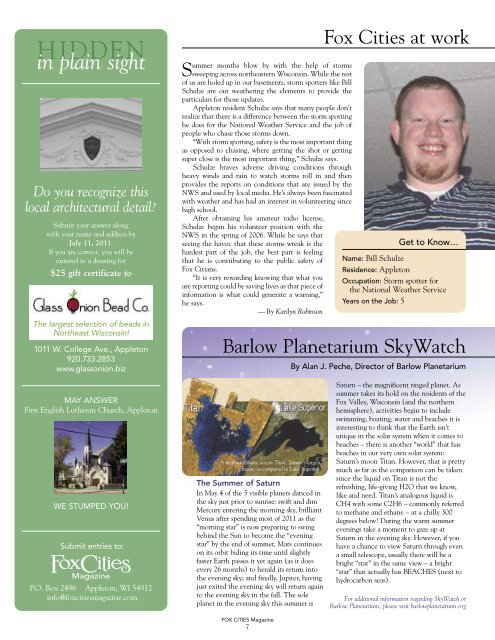127 FCM COVER - Fox Cities Magazine
127 FCM COVER - Fox Cities Magazine
127 FCM COVER - Fox Cities Magazine
You also want an ePaper? Increase the reach of your titles
YUMPU automatically turns print PDFs into web optimized ePapers that Google loves.
HIDDEN<br />
in plain sight<br />
Do you recognize this<br />
local architectural detail?<br />
Submit your answer along<br />
with your name and address by<br />
July 11, 2011.<br />
If you are correct, you will be<br />
entered in a drawing for<br />
$25 gift certificate to<br />
The largest selection of beads in<br />
Northeast Wisconsin!<br />
1011 W. College Ave., Appleton<br />
920.733.2853<br />
www.glassonion.biz<br />
MAY ANSWER<br />
First English Lutheran Church, Appleton<br />
WE STUMPED YOU!<br />
Submit entries to:<br />
P.O. Box 2496 Appleton, WI 54912<br />
info@foxcitiesmagazine.com<br />
Summer months blow by with the help of storms<br />
sweeping across northeastern Wisconsin. While the rest<br />
of us are holed up in our basements, storm spotters like Bill<br />
Schulze are out weathering the elements to provide the<br />
particulars for those updates.<br />
Appleton resident Schulze says that many people don’t<br />
realize that there is a difference between the storm spotting<br />
he does for the National Weather Service and the job of<br />
people who chase those storms down.<br />
“With storm spotting, safety is the most important thing<br />
as opposed to chasing, where getting the shot or getting<br />
super close is the most important thing,” Schulze says.<br />
Schulze braves adverse driving conditions through<br />
heavy winds and rain to watch storms roll in and then<br />
provides the reports on conditions that are issued by the<br />
NWS and used by local media. He’s always been fascinated<br />
with weather and has had an interest in volunteering since<br />
high school.<br />
After obtaining his amateur radio license,<br />
Schulze began his volunteer position with the<br />
NWS in the spring of 2006. While he says that<br />
seeing the havoc that these storms wreak is the<br />
hardest part of the job, the best part is feeling<br />
that he is contributing to the public safety of<br />
<strong>Fox</strong> Citians.<br />
“It is very rewarding knowing that what you<br />
are reporting could be saving lives as that piece of<br />
information is what could generate a warning,”<br />
he says.<br />
— By Karilyn Robinson<br />
The Summer of Saturn<br />
In May 4 of the 5 visible planets danced in<br />
the sky just prior to sunrise: swift and dim<br />
Mercury entering the morning sky, brilliant<br />
Venus after spending most of 2011 as the<br />
“morning star” is now preparing to swing<br />
behind the Sun to become the “evening<br />
star” by the end of summer, Mars continues<br />
on its orbit biding its time until slightly<br />
faster Earth passes it yet again (as it does<br />
every 26 months) to herald its return into<br />
the evening sky; and finally, Jupiter, having<br />
just exited the evening sky will return again<br />
to the evening sky in the fall. The sole<br />
planet in the evening sky this summer is<br />
Get to Know…<br />
Name: Bill Schulze<br />
Residence: Appleton<br />
Occupation: Storm spotter for<br />
the National Weather Service<br />
Years on the Job: 5<br />
Barlow Planetarium SkyWatch<br />
A methane/ethane sea on Titan, Saturn’s largest<br />
moon, as compared to Lake Superior.<br />
<strong>Fox</strong> <strong>Cities</strong> at work<br />
By Alan J. Peche, Director of Barlow Planetarium<br />
Saturn – the magnificent ringed planet. As<br />
summer takes its hold on the residents of the<br />
<strong>Fox</strong> Valley, Wisconsin (and the northern<br />
hemisphere), activities begin to include<br />
swimming, boating, water and beaches it is<br />
interesting to think that the Earth isn’t<br />
unique in the solar system when it comes to<br />
beaches – there is another “world” that has<br />
beaches in our very own solar system:<br />
Saturn’s moon Titan. However, that is pretty<br />
much as far as the comparison can be taken<br />
since the liquid on Titan is not the<br />
refreshing, life-giving H2O that we know,<br />
like and need. Titan’s analogous liquid is<br />
CH4 with some C2H6 – commonly referred<br />
to methane and ethane – at a chilly 300<br />
degrees below! During the warm summer<br />
evenings take a moment to gaze up at<br />
Saturn in the evening sky. However, if you<br />
have a chance to view Saturn through even<br />
a small telescope, usually there will be a<br />
bright “star” in the same view – a bright<br />
“star” that actually has BEACHES (next to<br />
hydrocarbon seas).<br />
For additional information regarding SkyWatch or<br />
Barlow Planetarium, please visit barlowplanetarium.org<br />
FOX CITIES <strong>Magazine</strong><br />
7















